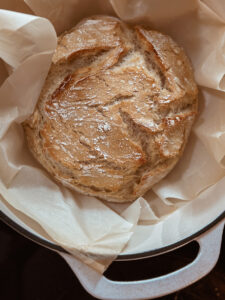 For many people, the mention of roses conjures up images of perfectly formed florist’s blossoms, surrounded perhaps by a cloud of tiny white Baby’s Breath sprays at Valentine’s Day; or perhaps like me, you grew up seeing vines of powder pink “wild” roses climb chimneys and scramble over the roofs of coastal cottages. There are hundreds of variations on what qualifies as a rose, and whether your tastes run to the perfection of form as with the long-stemmed hybrids preferred by florists, or the heavily scented “cabbage” roses depicted by Renaissance painters, there’s a rose for everybody. In this first of two articles, we’ll look at the basics of growing roses, and dispel some of the common myths about their care and feeding.
For many people, the mention of roses conjures up images of perfectly formed florist’s blossoms, surrounded perhaps by a cloud of tiny white Baby’s Breath sprays at Valentine’s Day; or perhaps like me, you grew up seeing vines of powder pink “wild” roses climb chimneys and scramble over the roofs of coastal cottages. There are hundreds of variations on what qualifies as a rose, and whether your tastes run to the perfection of form as with the long-stemmed hybrids preferred by florists, or the heavily scented “cabbage” roses depicted by Renaissance painters, there’s a rose for everybody. In this first of two articles, we’ll look at the basics of growing roses, and dispel some of the common myths about their care and feeding.
If your experience with roses has been limited to seeing someone in your family or neighborhood constantly fussing with their plants, you may have concluded that roses are hard to grow and require constant care. Nothing could be further from the truth! I can’t tell you how many really good books on the subject will say quite plainly, “roses love to grow!” There is no need to fuss over your vines and bushes unless you choose to; and even then, I doubt you will much improve upon what the rose does quite naturally given just a few basics, beginning with planting. There are two different ways to plant a rose, and we’ll look at them here.
A trip through any garden center at this time of year will no doubt present the prospective grower with two alternatives where growing roses is concerned: bare root and potted. When you see a collection of flowerless canes poking out of the end of a sleeve of plastic with a picture on it, often sitting in some water, you’re looking at a bare root plant. It may have a few leaves beginning to bud on the canes, or it may still be completely dormant with only some thorns showing; but in any case, bare root planting differs only slightly from the roses that have already been potted. For both, a hole bigger across and deeper than you think you need is dug, and then backfilled with the removed dirt amended with rich humus material such as “finished” compost. The idea here is that as the roots grow and feel their way outward and downward, you want them to have an easy time of it and plenty of nutrients to find in the soil.
Keeping in mind that while some roses will tolerate a little dappled shade, they prefer full sun, and do best in a location where the ground drains well. If you’re planting your roses as part of a garden setting, leave them some breathing room for air circulation. Rose experts will tell you to test your soil, adjust its Ph, etc but I’ve had equal success with plants sunk into richly amended soil on both coasts of the U.S. (i.e. quite alkaline and extremely acid) and have enjoyed success with both. I’ve used composted cow manure from the garden center when I didn’t have a place to make my own compost, and in all cases, I also throw half a handful of bone meal or dried powdered egg shells into each hole and mix it around. The only adjustment I make, as I alluded to above, is in whether planting a potted rose or a bare root.
For a potted rose, the bottom of the hole after backfilling is left rather flat. The root ball is either scored carefully (if it looks pot bound) or the roots can be very gently pulled loose to encourage them to do something other than continue growing in circles, and then more amended soil is backfilled all around the root ball.  For a bare root rose, the plastic is removed and the plant stood for an hour or so in water which, ideally, has been laced with a few drops of root stimulant. My favorite is a liquid product that smells distinctly of B vitamins. Now remember, we’ve dug a hole that’s deeper and wider than we thought we’d need (for the engineers out there, a hole about 18″ across and as deep is a good starting point) but this time, when we backfill with our nice, rich soil and amendments, we form an upward-pointing cone in the bottom of the hole. The idea here is that we’re going to spread the roots and sit the plant atop this cone and then backfill over and around the roots up to ground level. As with the potted plant, the bud union – a sort of knob that’s formed on plants that have been grafted – is above the soil and all root material is covered. If you wish, you can form a little watering basin around your rose with your extra soil; and if you’ll be using a soaker hose that will be left in place, you can make a circle with it and lie it loosely around the base of our rose.
For a bare root rose, the plastic is removed and the plant stood for an hour or so in water which, ideally, has been laced with a few drops of root stimulant. My favorite is a liquid product that smells distinctly of B vitamins. Now remember, we’ve dug a hole that’s deeper and wider than we thought we’d need (for the engineers out there, a hole about 18″ across and as deep is a good starting point) but this time, when we backfill with our nice, rich soil and amendments, we form an upward-pointing cone in the bottom of the hole. The idea here is that we’re going to spread the roots and sit the plant atop this cone and then backfill over and around the roots up to ground level. As with the potted plant, the bud union – a sort of knob that’s formed on plants that have been grafted – is above the soil and all root material is covered. If you wish, you can form a little watering basin around your rose with your extra soil; and if you’ll be using a soaker hose that will be left in place, you can make a circle with it and lie it loosely around the base of our rose.
At this point, for both the potted plant and the bare root, we water them in, which is to say we gently flood the area, wiggling the plant just a little to encourage pockets of air to bubble up. When the bubbling has stopped, we add a bit more soil to fill any gaps that have formed, lean on the soil with our hands around the backfilled area to firm it, and water once again. It never hurts to add a bit of root stimulant to this watering-in process, but don’t put fertilizer on your plant at this stage. It’s going to go through a bit of shock, especially if it was potted, and you don’t want to stress it any further by adding a big slug of extra nutrients to the occasion.
If you like to mulch your plants, this is the time to do it. I’ve had success with making a “bib” of landscape fabric around the plant and then covering that with mulch to help prevent weeds, but the choice is yours. Over the coming days and weeks, water your rose regularly (but of course don’t keep the soil soggy) and if you’ve chosen a healthy plant to start with and put it in a  good location, you should start seeing results pretty quickly! I’ve never planted a rose in the Spring that didn’t reward me with flowers right from the first season onward. If your rose looks as though it’s growing fast and/or is flowering heavily, consider feeding it at about once or twice during the Summer.
good location, you should start seeing results pretty quickly! I’ve never planted a rose in the Spring that didn’t reward me with flowers right from the first season onward. If your rose looks as though it’s growing fast and/or is flowering heavily, consider feeding it at about once or twice during the Summer.
Now, the subject of what and how to feed roses is one of those discussions that can spark some lively debate, so I’ll tell you what I’ve learned and you’ll of course be the judge. I treat my roses the same way I’d treat my fruit trees or annuals – I give them either an occasional side-dressing of composted manure (horse or cow) or I make “manure tea” and water them with it. There are lots of chemical rose foods on the market, some with built-in systemic insect repellant, but I don’t use them. I’ve never felt the need to use anything synthetic when Mother Nature’s plant food is so readily available and inexpensive. What’s more, especially in the case of the systemic bug repellant, I am unwilling to take a chance that any residue from it could wind up in my cup of rose hip tea or hydrosol if I make them (more on those in Part Two).
Insects that tend to attack roses include aphids and, east of the Mississippi, Japanese Beetles. I’ve found that a healthy rose, kept watered sufficiently and growing well doesn’t seem to interest aphids nearly as much as a wilting or stressed plant; but if they do visit, they’re easily blasted off with a spray of water or at most, a light dusting with pyrethrum powder. Growing French Marigolds near your roses also helps, as the scent they give off repels quite a number of insects. The Japanese Beetle, however, is another story and among the few garden pests that bring out the worst in me. There is nothing I can find to admire about them and I have no conscience about wiping them out wholesale when they emerge. But I do have a weapon. Milky Spore Disease.
Milky Spore is just about the only natural control for Japanese Beetles, and if there is a downside to using it, it’s only that it takes a while to spread. Basically, it is “plugged” into the ground, preferably a thimbleful or so at a time, into little holes you make in the soil around plantings you want to protect. I make these with (ironically) Japanese-style chopsticks. I gently push the smaller end into the soil to a depth of a couple of inches and spoon in a bit of Milky Spore powder. The closer together these “plugs” the faster the disease will spread. A good spacing is a grid of every 6 to 8″ depending upon your patience and your budget, in concentric circles outward from each plant until they overlap. Milky Spore isn’t cheap, but it doesn’t die off or have to be reapplied. Once it’s in the soil and the ground is warm enough, it goes to work.
 How it works is this – the Japanese Beetle grubs ingest the spore it grows and multiplies in the grub. At some point, the grub simply explodes and the disease is spread further. Next grub comes along, swells up and explodes, and so on. The good news is, this spore does not affect earthworms or other beneficials, nor will it harm any bird that gets hold of an infected grub. This is a win-win situation, but it takes time. The first couple of years, plan on doing a lot of hand-picking of the adult beetles, and if you don’t live in the ‘burbs, those yellow traps placed at some distance from your ornamentals do work – just be prepared to empty them frequently as they fill up quickly and smell awful. I don’t recommend them for people living in a regular suburban setting because all you’re doing in that case is “calling all Beetles” away from your neighbors’ yards to your own. That said, if a group of you got together, planted Milky Spore and everyone put out traps for the meantime, you may enjoy some success.
How it works is this – the Japanese Beetle grubs ingest the spore it grows and multiplies in the grub. At some point, the grub simply explodes and the disease is spread further. Next grub comes along, swells up and explodes, and so on. The good news is, this spore does not affect earthworms or other beneficials, nor will it harm any bird that gets hold of an infected grub. This is a win-win situation, but it takes time. The first couple of years, plan on doing a lot of hand-picking of the adult beetles, and if you don’t live in the ‘burbs, those yellow traps placed at some distance from your ornamentals do work – just be prepared to empty them frequently as they fill up quickly and smell awful. I don’t recommend them for people living in a regular suburban setting because all you’re doing in that case is “calling all Beetles” away from your neighbors’ yards to your own. That said, if a group of you got together, planted Milky Spore and everyone put out traps for the meantime, you may enjoy some success.
Other things that you often hear about plaguing roses are black spot and mildew. I’m not sure why, but I have never, even once, had my roses bothered by either. I strongly suspect that the black spot is like the aphids and doesn’t stand much of a chance with a healthy plant; and given that I allow space around each rose for good air circulation (read: dew being able to dry completely) mildew has never been an issue with my roses or anything else I’ve grown, even here in the mid-Atlantic where “humidity R us.” That said, if those of you reading this are already experienced with mildew and have conquered it, I’d be interested in hearing what you did.
Next time, we’ll talk about the different kinds of roses that are available, which ones lend themselves to being useful in the kitchen or craft room, and I’ll share some of my favorites with you. Meanwhile, for those who are absolute beginners and wish to try their hand at growing roses, I’d like to suggest as your first effort Mr. Lincoln, a wonderful deep red rose appreciated by men and women alike. It’s nearly foolproof and has a strong, old-fashioned rose scent. Good luck!


































Thank you Sherry for the advice on naturally combating Japanese beetles! Their grubs DESTROYED our lawn last summer (they love our roses and weeping cherry tree) and it’s still not back to normal. Now we’re worried about this year, and we are NOT “treat your lawn” type people. We will look into the milky spore idea – I’ll have hubby check at our little gardening center downtown. Does it start working as soon as you use it?
Here is Sherry’s response (which she couldn’t get to post and finally emailed to me) – I thought you all would find it helpful:
Yes, Milky Spore works as soon as the soil is warm enough for the grubs to start ingesting the roots (and disease spores) – the speed of results is directly proportional to how closely together the “plugs†of powder are installed. Even with a good, heavy application though, the likelihood is, you won’t see a really dramatic change this first year.
I should mention that any areas of your lawn that are already badly affected can be thickly overseeded with Kentucky 31, a grass which naturally contains endophytes that are also deadly to grubs. The one place this type of seed is not to be used is anyplace where pregnant mares or their foals will graze, as the otherwise helpful endophytes are dangerous for the developing fetus/foal.
Hope that helps,
Best regards,
Sherry E.